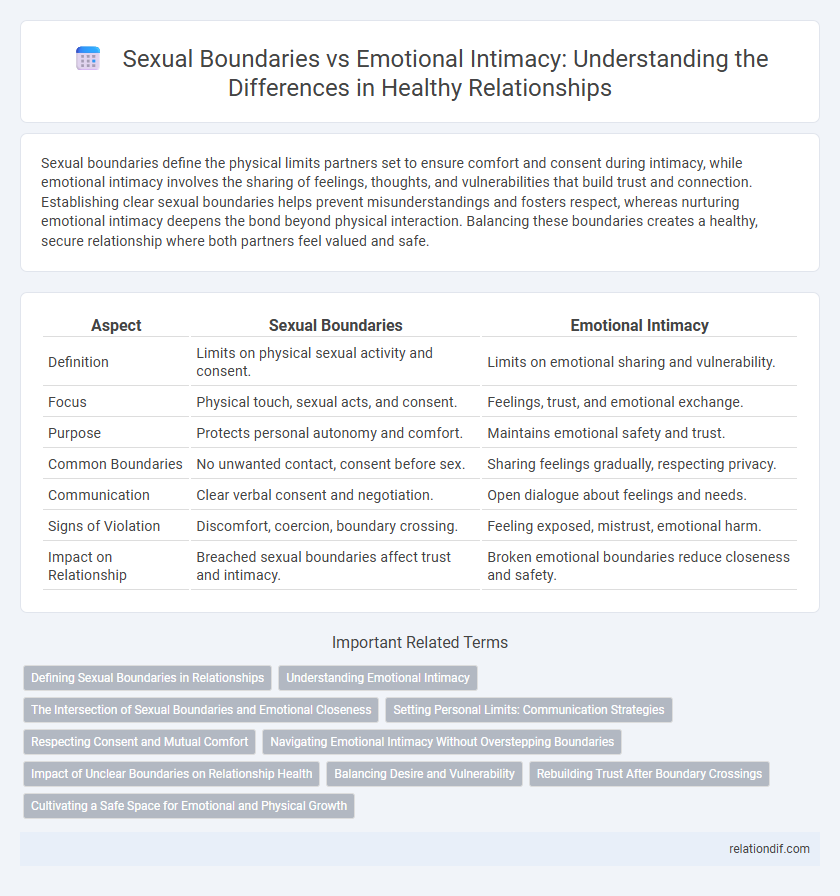Sexual boundaries define the physical limits partners set to ensure comfort and consent during intimacy, while emotional intimacy involves the sharing of feelings, thoughts, and vulnerabilities that build trust and connection. Establishing clear sexual boundaries helps prevent misunderstandings and fosters respect, whereas nurturing emotional intimacy deepens the bond beyond physical interaction. Balancing these boundaries creates a healthy, secure relationship where both partners feel valued and safe.
Table of Comparison
| Aspect | Sexual Boundaries | Emotional Intimacy |
|---|---|---|
| Definition | Limits on physical sexual activity and consent. | Limits on emotional sharing and vulnerability. |
| Focus | Physical touch, sexual acts, and consent. | Feelings, trust, and emotional exchange. |
| Purpose | Protects personal autonomy and comfort. | Maintains emotional safety and trust. |
| Common Boundaries | No unwanted contact, consent before sex. | Sharing feelings gradually, respecting privacy. |
| Communication | Clear verbal consent and negotiation. | Open dialogue about feelings and needs. |
| Signs of Violation | Discomfort, coercion, boundary crossing. | Feeling exposed, mistrust, emotional harm. |
| Impact on Relationship | Breached sexual boundaries affect trust and intimacy. | Broken emotional boundaries reduce closeness and safety. |
Defining Sexual Boundaries in Relationships
Defining sexual boundaries in relationships involves clear communication about comfort levels, consent, and expectations to ensure mutual respect and safety. Establishing these boundaries distinguishes physical intimacy from emotional intimacy, allowing partners to navigate desires and limits without confusion or pressure. Prioritizing consent and openly discussing preferences helps build trust and strengthens the emotional connection while maintaining individual autonomy.
Understanding Emotional Intimacy
Understanding emotional intimacy requires recognizing the difference between sexual boundaries and emotional closeness, where emotional intimacy involves sharing deep feelings, vulnerabilities, and trust beyond physical connection. Healthy boundaries ensure that emotional sharing occurs at a comfortable pace, preventing overwhelming exposure while fostering genuine connection. Establishing clear distinctions between sexual and emotional boundaries supports stronger relationships and promotes mutual respect.
The Intersection of Sexual Boundaries and Emotional Closeness
Sexual boundaries and emotional intimacy intersect where trust and consent create a safe space for vulnerability and connection. Clear communication about personal limits enhances emotional closeness by fostering understanding and respect between partners. Navigating this intersection carefully supports healthier relationships by balancing physical desires with emotional needs.
Setting Personal Limits: Communication Strategies
Setting personal limits in sexual boundaries involves clear and honest communication to ensure comfort and consent, emphasizing verbal and non-verbal cues. Employing assertive communication strategies like using "I" statements helps express feelings and needs without alienating a partner, fostering mutual respect. Recognizing the difference between sexual boundaries and emotional intimacy allows individuals to maintain their autonomy while deepening trust through open dialogue.
Respecting Consent and Mutual Comfort
Respecting consent and ensuring mutual comfort are essential in navigating sexual boundaries versus emotional intimacy, as clear communication prevents misunderstandings and builds trust. Establishing and honoring personal limits fosters a safe environment where both partners feel valued and emotionally secure. Prioritizing consent reinforces autonomy and deepens emotional connection, creating a balanced dynamic between physical interactions and emotional closeness.
Navigating Emotional Intimacy Without Overstepping Boundaries
Navigating emotional intimacy requires clear communication to respect personal boundaries while fostering trust and connection. Establishing and maintaining sexual boundaries ensures that emotional closeness does not lead to unwanted physical advances, preserving mutual comfort and consent. Recognizing individual limits allows partners to deepen emotional intimacy safely, promoting a balanced and healthy relationship dynamic.
Impact of Unclear Boundaries on Relationship Health
Unclear sexual boundaries often lead to confusion and mistrust, undermining the foundation of emotional intimacy within a relationship. Without clearly defined limits, partners may experience increased anxiety, resentment, and emotional disconnection, which deteriorates overall relationship satisfaction. Establishing and respecting both sexual and emotional boundaries is crucial for fostering trust, security, and mutual understanding in healthy relationships.
Balancing Desire and Vulnerability
Balancing desire and vulnerability requires setting clear sexual boundaries while fostering emotional intimacy to build trust and respect. Establishing limits on physical interactions helps maintain personal comfort, while open communication about feelings deepens connection without compromising individual needs. Navigating this balance supports healthy relationships where both passion and emotional safety coexist harmoniously.
Rebuilding Trust After Boundary Crossings
Rebuilding trust after boundary crossings requires clear communication and consistent respect for both sexual boundaries and emotional intimacy limits. Establishing mutual understanding involves acknowledging past violations while setting firm, transparent guidelines to prevent recurrence. Prioritizing consent and emotional safety creates a foundation where trust can be restored and relationships strengthened.
Cultivating a Safe Space for Emotional and Physical Growth
Establishing clear sexual boundaries enhances trust and respect, creating a foundation for deeper emotional intimacy within relationships. Defining mutual limits allows partners to feel secure, fostering open communication and vulnerability essential for emotional and physical growth. Prioritizing consent and emotional safety cultivates a nurturing environment where both partners can explore their connection without fear or judgment.
sexual boundaries vs emotional intimacy Infographic

 relationdif.com
relationdif.com